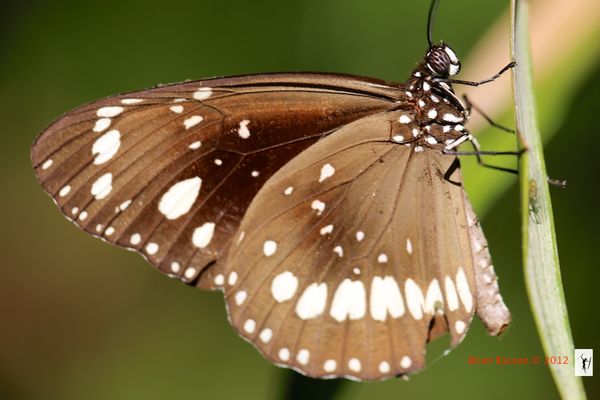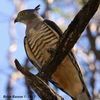Check out Commercial and Industrial Photography section of our forum.
Australian Crow Butterfly
Nov 26, 2012 19:25:31 #
Hi Nikonian, and all other macro photographers on UHH. I took this on Sunday, and was able to get really close with my Canon 100-mm macro lens, ISO 100, 1/250-sec at f/4.5. I believe that this is a true macro photo. Please critique and let me know what you think. Brian
Australian Crow Butterfly ♀

Nov 26, 2012 21:51:15 #
We cannot know if this is a macro or a close-up, without knowing size of butterfly. If it is about 1-inch (25-mm) from wingtip to feet, then this life-size, 1:1 magnification: a macro-photograph.
Nov 26, 2012 22:44:53 #
Nikonian72 wrote:
Hi Nikonian72, Thank you for responding so quickly and your input. I found the information below on the internet: We cannot know if this is a macro or a close-up, without knowing size of butterfly. If it is about 1-inch (25-mm) from wingtip to feet, then this life-size, 1:1 magnification: a macro-photograph.
Common Crow Euploea core
♂ 69 mm, ♀ 72 mm. Common dark brown butterfly with white spots and slow flight, usually fairly low. I think that these sizes are from wingtip to wingtip - Source: http://www.sunbittern.com/publications%20seq%20butterflies.pdf
In my opinion the butterfly that I photographed was within the size parameter that you provided. I hope that this helps? Brian
Check out Close Up Photography section of our forum.
Nov 27, 2012 00:01:45 #
Shaka wrote:
Female = 72-mm wingtip-to-wingtip is difficult to translate to a folded-wing profile image, as you captured. Best method to capture macro is to have lens pre-set to manual MFD, then physically moving camera/lens set-up, in-&-out until focus is achieved. That point of focus is 1:1 magnification.In my opinion the butterfly that I photographed was within the size parameter that you provided. I hope that this helps? Brian
Nov 27, 2012 01:35:13 #
Nikonian72 wrote:
Hi Nikonian, I agree, it is probably impossible to translate wingtip-to-wingtip measurement to a folded wing profile. In any event, when I took this photo I started off by using manual; I think that I had the lens preset 1:1 and then moved my lens in and out, but after many shots I believe that I was manual focusing rather than moving in and out! What a disaster for me! Is my face red, or what! :oops: I'll try to remember keep to the rules next time. Many thanks, Nikonian, for your critique! Sincerely appreciated! :oops:Female = 72-mm wingtip-to-wingtip is difficult to translate to a folded-wing profile image, as you captured. Best method to capture macro is to have lens pre-set to manual MFD, then physically moving camera/lens set-up, in-&-out until focus is achieved. That point of focus is 1:1 magnification.
Nov 27, 2012 02:39:19 #
Most butterflies are too large to completely capture in a single macro-photographs, so overall photos, like yours, are needed, and are usually labeled 1:2 or 1/2 life-size, etc. Life-size images of most butterflies are just the head & body sections.
Nov 27, 2012 04:00:23 #
Nikonian72 wrote:
Thank you Nikonian72, appreciated.Most butterflies are too large to completely capture in a single macro-photographs, so overall photos, like yours, are needed, and are usually labeled 1:2 or 1/2 life-size, etc. Life-size images of most butterflies are just the head & body sections.
Check out Advice from the Pros section of our forum.
Nov 27, 2012 09:39:36 #
Nov 27, 2012 10:29:10 #
Nov 27, 2012 12:43:57 #
With my 60D plus 100mm L macro lens, to get a true macro shot I use a tripod, Live view so I can use the critical focusing magnification button, set the lens 1:1 set the focusing to manual and move in or out to get the focusing just right. The closest you can get is around 1 foot or(30cm) if I remember correctly. In my experience so far I have not been able to get so close or have the time to get a macro butterfly shot. Many people regard a cropped shot inlarged to lifesize makes a macro shot. I cant accept this as a macro even though it would be life size or bigger. This lens is very sharp and I have taken shots from 3 feet or more which when enlarged look to some like macro..regards :-)
Nov 27, 2012 13:21:28 #
Robbie7 wrote:
A 100-mm macro lens on a Canon camera with an APS-C sensor will capture "true macro" at 160-mm = 6.3-inches Working Distance (lens front element to subject). Anything farther away is a close-up capture.With my 60D plus 100mm L macro lens, to get a true... (show quote)
For printing or posting, it makes little difference if your crop in the camera (captured macro) or crop in post processing (captured close-up) to macro proportions.
Working Distance is a personal preference. For normal insect & arachnid photography, I prefer the greater DoF possible with close-up in the 1:2 to near 1:1 range, then cropped for composition, etc., in PP. For extremely small insects, MFD is my preference, and added cropping PP, to larger than life-size.
Nov 27, 2012 13:53:41 #
Hi Nikonian :-) Thanks for pointing out the crop factor, I knew when I was writing my comment that I had been able to get closer than 30cm but was too lazy to go into it in my head. I agree with point 2 i.e. printing and posting and also point no3 is why I dont shoot much macro either.The part I cant accept is when people refer to an enlarged close up as a macro. Thanks for responding :-)
Nov 27, 2012 15:16:22 #
rayford2
Loc: New Bethlehem, PA
Robbie7 wrote:
Can you tell if an image is an enlarged close-up or a true macro without any camera data?Hi Nikonian :-) Thanks for pointing out the crop factor, I knew when I was writing my comment that I had been able to get closer than 30cm but was too lazy to go into it in my head. I agree with point 2 i.e. printing and posting and also point no3 is why I dont shoot much macro either.The part I cant accept is when people refer to an enlarged close up as a macro. Thanks for responding :-)
Nov 27, 2012 18:30:34 #
Robbie7 wrote:
Enlarging & cropping a 1:2 (1/2 life-size) close-up to macro isn't too bad, but trying to crop a 1:3 or 1:4, or wider close-up, starts to fall apart when cropped to 1:1 mag (life-size). Original image resolution is the limiting factor when trying to crop a close-up to macro proportions. Same problem when trying to enlarge an image to print.Hi Nikonian :-) Thanks for pointing out the crop factor, I knew when I was writing my comment that I had been able to get closer than 30cm but was too lazy to go into it in my head. I agree with point 2 i.e. printing and posting and also point no3 is why I dont shoot much macro either.The part I cant accept is when people refer to an enlarged close up as a macro. Thanks for responding :-)
Nov 27, 2012 18:44:20 #
Hello Rayford :D I am going to stick my neck out here :( The quality of a macro shot depends on various factors e.g. Camera, lens, lighting, attachments used etc etc.
I can only speak as a Canon user but I know that the photos I take from several feet away i.e. non macro, when blown up to lifesize or more would be as sharp if not sharper and finer detailed than a photo taken with a less quality lens on macro setting. When I take a macro with my 100mm L lens the difference between it and a non macro from my lens is very noticeable. Why bother having a macro setting if it wasn't :-). So to answer your question without having the exif data it would be difficult, but generally in my opinion you can suspect, through experience when a blow up is just that. My pictures in the gallery of the Damselle fly taken on a fuji bridge camera were taken on the close up setting which has a macro symbol on it. The images though reasonable do not have the fine detail that my Canon would have , even in non macro mode. Maybe Nikonian72 knows some technical formula that I dont, so put the same qestion to him. I do know this I have never yet got so close to a jumping or fidgety insect to take its photo in true Macro (1:1). Obviously if you have the money for specialist equipment you could capture a flea in flight but how many on this site at our level would possess such kit. At the end of the day there is macro and macro. I have seen some amazing shots taken in macro as I am sure you have., but never one thats called macro, but been shot in non macro setting and blown up. Conclusion: Without exif data,I could not put hand on heart and swear I would definately know, but I bet I wouldn't be far out with my assumption .. :thumbup:
I can only speak as a Canon user but I know that the photos I take from several feet away i.e. non macro, when blown up to lifesize or more would be as sharp if not sharper and finer detailed than a photo taken with a less quality lens on macro setting. When I take a macro with my 100mm L lens the difference between it and a non macro from my lens is very noticeable. Why bother having a macro setting if it wasn't :-). So to answer your question without having the exif data it would be difficult, but generally in my opinion you can suspect, through experience when a blow up is just that. My pictures in the gallery of the Damselle fly taken on a fuji bridge camera were taken on the close up setting which has a macro symbol on it. The images though reasonable do not have the fine detail that my Canon would have , even in non macro mode. Maybe Nikonian72 knows some technical formula that I dont, so put the same qestion to him. I do know this I have never yet got so close to a jumping or fidgety insect to take its photo in true Macro (1:1). Obviously if you have the money for specialist equipment you could capture a flea in flight but how many on this site at our level would possess such kit. At the end of the day there is macro and macro. I have seen some amazing shots taken in macro as I am sure you have., but never one thats called macro, but been shot in non macro setting and blown up. Conclusion: Without exif data,I could not put hand on heart and swear I would definately know, but I bet I wouldn't be far out with my assumption .. :thumbup:
If you want to reply, then register here. Registration is free and your account is created instantly, so you can post right away.
Check out Professional and Advanced Portraiture section of our forum.



